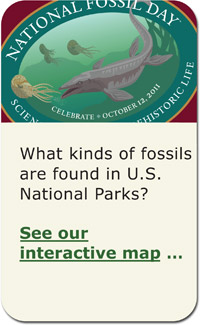
Finding fossils in national parks — a new interactive map on PaleoPortal
by Mark Goodwin
 |
Some parks have fossils that are (1) found in rocks used in construction, (2) associated with archeological sites, or (3) on display in visitor centers/park museums. If a park has fossils — whether they were found there or not — it will be on the map. For example, no fossils have been found (so far) at the John Muir National Historic Site in Martinez, CA; however, there is a specimen of petrified wood from Arizona's Petrified Forest in the park's collections because of Muir's excavations and observations that he made there in 1905–1906. So it's on the map! Incidentally, phytosaur bones that Muir recovered at that time are now in UCMP's collections.
UCMP would like to thank software developer Seth Kaufman for "building" the interactive map, Vince Santucci of the NPS Geologic Resources Division for providing us with the documents necessary to produce this resource, and Dave Smith, UCMP graphic designer and PaleoPortal webmaster, for gleaning the data from those documents and entering them into the database.